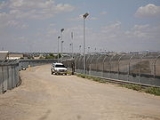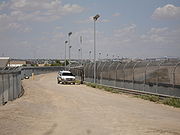
Secure Fence Act of 2006
Encyclopedia

The bill was introduced on Sep. 13, 2006 by Peter T. King (R-NY). In the House of Representatives, the Fence Act passed 283 -138 on September 14, 2006. On September 29, 2006 - the Fence Act passed in the Senate 80 -19. Most Republicans voted in support of the Fence Act while most Democrats voted against it.
The Secure Fence Act of 2006’s goal is to help secure America’s borders to decrease illegal entry, drug trafficking, and security threats by building 700 miles (1,126.5 km) of physical barriers along the Mexico-United States border. Additionally, the law authorizes more vehicle barriers, checkpoints, and lighting as well as authorizes the Department of Homeland Security to increase the use of advanced technology like cameras, satellites, and unmanned aerial vehicles to reinforce our infrastructure at the border. Congress approved $1.2 billion in a separate homeland security spending bill to bankroll the fence, though critics say this is $4.8 billion less than what’s likely needed to get it built.
Proponents of the bill believe that it will cut off vehicle transport of illegal immigrants, forcing those who want to enter the country to pursue legal channels or cover potentially hundreds of miles on foot and overcome a difficult obstacle. This will increase the number of apprehensions of illegal immigrants. It could also help contain the illegal drug trade
Illegal drug trade
The illegal drug trade is a global black market, dedicated to cultivation, manufacture, distribution and sale of those substances which are subject to drug prohibition laws. Most jurisdictions prohibit trade, except under license, of many types of drugs by drug prohibition laws.A UN report said the...
pouring into the US from Mexico as well as provide additional protection from terrorist entry into the country.
Opponents of the bill argue that it is not an effective strategy to curb illegal immigration because the fence is not a continuous barrier and can be climbed over or dug under in some areas. They also argue that it could harm US-Mexico relations, disrupt the environment and natural migration of wildlife, as well as increase the danger and risk of Immigrant workers attempting to cross the border. Further, opponents argue that because of the increased risk of crossing the border, illegal immigrants who previously pursued seasonal work and then returned home may have to bring their families and live permanently in the country.
Since construction of the wall began “apprehensions, a rough proxy for measuring illegal crossings, were down 18% at the southern border in 2008 and Border Patrol attributes some of that to the fence. But a report in May 2009 by the Congressional Research Service found "strong indication" that illegal crossers had simply found new routes.”
On January 23, 2008 the 110th Congress introduced Reinstatement of the Secure Fence Act of 2008 (H.R. 5124). This bill called for Homeland Security to construct an additional 700 miles of two layered, 14 foot high fencing along the southwest border. The bill died in committee and was never voted upon.
By April 2009 Homeland Security had erected about 613 miles of new pedestrian fencing and vehicle barriers along the southwest border from California to Texas.
In May of 2010, Senator Jim DeMint (R-SC) unsuccessfully reintroduced for the second time his “Finish the Fence” amendment which would require Homeland Security to construct an additional 353 miles (568.1 km) of fencing along the US-Mexico border.
External links
- The Wall: A film documenting the impact of a fence on the U.S./Mexico border.
- HR 6061, Secure Fence Act of 2006 via THOMASTHOMASTHOMAS is the database of United States Congress legislative information. It is operated by the Library of Congress and was launched in January 1995 at the inception of the 104th Congress...

